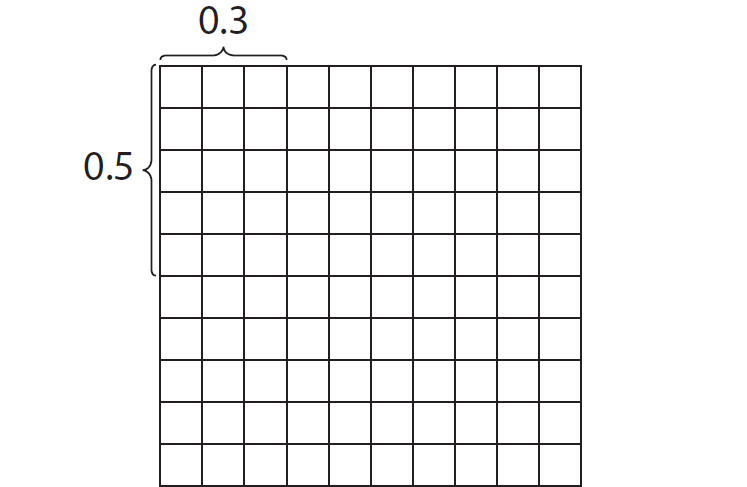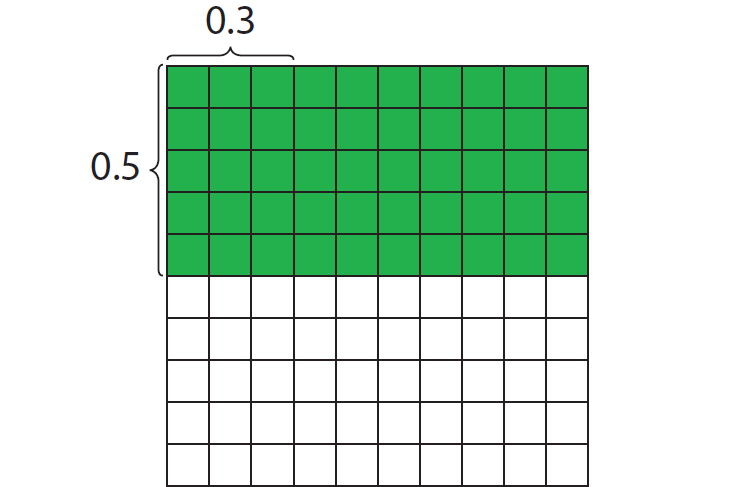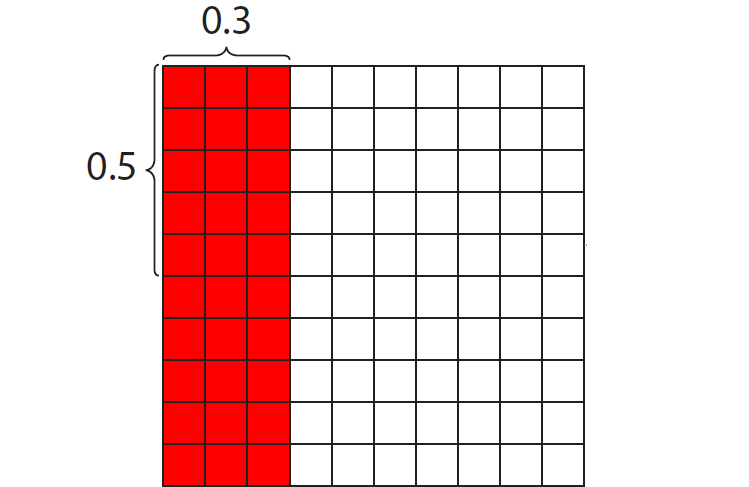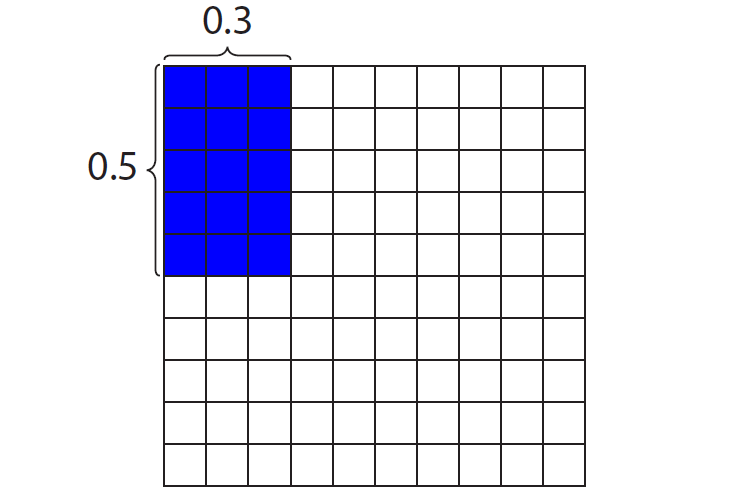MODELING DECIMAL MULTIPLICATION
Subscribe to our ▶️ YouTube channel 🔴 for the latest videos, updates, and tips.
Example 1 :
Multiply 0.3 and 0.5.
Solution :
To multiply 0.3 and 0.5, let us consider decimal grids given below.

0.3 × 0.5 represents 0.3 of 0.5.
Shade 5 rows of the decimal grid in green color to represent 0.5.

Shade 3 columns of the decimal grid in red color to represent 0.3.

Now shade the common region of 0.5 and 0.3 in blue color.

In the common region of 0.5 and 0.3 in blue color, there are 15 squares.
This represents 15 hundredths or 0.15.
Therefore, 0.3 x 0.5 = 0.15.
Example 2 :
Multiply 3.2 and 2.1.
Solution :
Let us use area model to multiply 3.2 and 2.1.

In this model, the large squares represent wholes, the small rectangles along the right and lower edges represent tenths, and the small squares at the lower right represent hundredths.
This model is 3 and 2 tenths units long, and 2 and 1 tenth units wide.
The area of the model is
6 wholes + 7 tenths + 2 hundredths sq. units
Therefore, 3.2 x 2.1 = 6.72.
Problem 1 :
Multiply 2.3 and 1.78.
Solution :
Imagine the given decimals as whole numbers.
Then, we have 23 and 178.
Now, multiply 23 and 178.
23 x 178 = 4094
In the first decimal 2.3, there is one digit after the decimal point and in 1.78, there are two digits after the decimal point.
So, we have
1 + 2 = 3
In the above result 4094, there must be 3 digits after the decimal.
Hence, 2.3 x 1.78 = 4.094.
Problem 2 :
The side of a square is 3.2 cm. Find its perimeter.
Solution :
All the sides of a square are equal.
Length of each side = 3.2 cm.
Perimeter of a square = 4 x side
Thus, perimeter = 4 x 3.2 = 12.8 cm.
Problem 3 :
The length of a rectangle is 6.3 cm and its width is 3.2 cm. What is the area of the rectangle?
Solution :
Formula for area of rectangle :
= length x width
Substitute length = 6.3 cm and width = 3.2 cm.
= 6.3 cm x 3.2 cm
= 20.16 cm2
Problem 4 :
Multiply 3.723 by 100.
Solution :
We multiply by 3.723 by 100. So, we have to move the decimal point two digits to the right.
3.723 x 100 = 372.3
Problem 5 :
Multiply 3.723 by 1000.
Solution :
We multiply by 3.723 by 1000. So, we have to move the decimal point two digits to the right.
3.723 x 1000 = 3723
Problem 6 :
The price of a fruit is $3.52 per lb. Find the cost of 10 lbs. of fruits.
Solution :
Given : Cost of 1 lb. of fruit = $3.52.
Then, the cost of 10 lbs. of fruits is
= 10 x 3.52
We multiply by 3.52 by 10. So, we have to move the decimal point one digit to the right.
= 35.2
Hence, the cost of 10 lbs. of fruits is $35.2.
Problem 7 :
A person walks regularly in the morning. If the speed of his walking is 43.26 ft. per minute, Find the distance covered by him in 100 minutes.
Solution :
Given : Speed is 43.26 ft. per minute.
So, distance covered in one minute is 43.26 ft.
We all know the formula for distance.
Distance = Speed x Time
Substitute time = 100 and speed = 43.26.
Distance = 43.26 x 100
We multiply by 43.26 by 100. So, we have to move the decimal point two digits to the right.
Distance = 4326 ft.
Problem 8 :
One-thousandth of a certain number is 0.003. What is the number?
Solution :
Given : One-thousandth of a certain number is 0.003.
Let 'a' be the number.
Then, from the given information, we get
(1/1000) x a = 0.003
Multiplying by 1000 on both sides, we get
a = 0.003 x 1000
We multiply by 0.003 by 1000. So, we have to move the decimal point three digits to the right.
a = 3
Hence, the the number is 3.
Problem 9 :
Murray bought 4 magazines that cost $3.95 each. How much did Murray spend on the magazines?
A) $3.95 B) $7.95 C) $15.80 D) $17.80
Solution :
Cost of each magazine = $3.95
Number of magazines he buys = 4
Total cost = 4 x 3.95
= $15.80
So, the required cost is $15.80, option C is correct.
Problem 10 :
Which shows the product of 0.06 x 0.005 ?
A) 0.30 B) 0.03 C) 0.003 D) 0.0003
Solution :
= 0.06 x 0.005
Converting each decimal as fractions with the denominators 10, 100, 1000,...... etc, the multiplication can be performed simply.
= 6/100 x 5/1000
= 30/100000
= 0.00030
Option D is correct..
Problem 11 :
What is the product of 0.42 x 0.6?
A) 0.252 B) 0.3 C) 2.52 D) 25.2
Solution :
0.42 x 0.6
Let us convert decimals as fraction and then multiply.
= 42/100 x 6/10
= 252/1000
= 0.252
Problem 12 :
Coach Kilroy bought ribbon to make medals for the soccer team. The ribbon cost $0.67 per foot and he bought 16 feet. How much did Coach Kilroy pay for the ribbon?
A) $1.07 B) $1.72 C) $10.72 D) $107.20
Solution :
Cost of ribbon per foot = $0.67
Length of ribbon he purchases = 16 feet
Amount to be spent for ribbon = 16 x 0.67
= $10.72
So, the required cost is $10.72.
Subscribe to our ▶️ YouTube channel 🔴 for the latest videos, updates, and tips.
Kindly mail your feedback to v4formath@gmail.com
We always appreciate your feedback.
©All rights reserved. onlinemath4all.com
Recent Articles
-
SAT Math Practice
Dec 05, 25 04:04 AM
SAT Math Practice - Different Topics - Concept - Formulas - Example problems with step by step explanation -
10 Hard SAT Math Questions (Part - 37)
Dec 03, 25 07:02 AM
10 Hard SAT Math Questions (Part - 37) -
Factorial Problems and Solutions
Dec 02, 25 09:27 AM
Factorial Problems and Solutions

